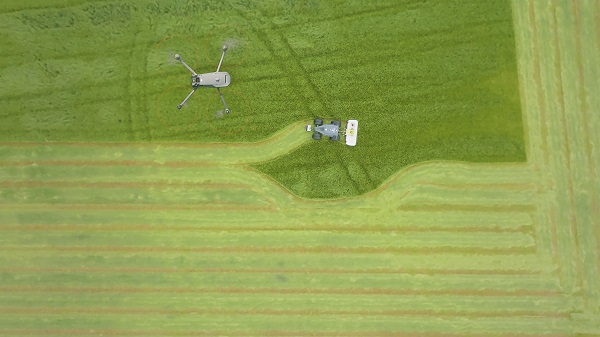Forage harvesting is one of the most labour-intensive phases on many farms, especially the high-yielding early cuts.
Before and during mowing, fields must be searched or scanned for wildlife – with operations such as mowing, tedding, swathing and clearance often going on at the same time. In future, autonomous tractors or AgBots will be able to lighten the workload for many farmers and contractors.
Tall-growing crops present a particular challenge, as does the continuous monitoring and assessment of work quality. Together with partners such as AgXeed and thermal DRONES, CLAAS is researching and testing different areas of application as the basis for further progress in development and standardisation.
A question of interface: highly automated and autonomous mowing with wildlife rescue by drone
Drones with thermal-imaging cameras are now a widespread, safe and effective means of detecting breeding nests and wildlife, especially roe deer fawns, just before mowing grassland or whole-crop silage.
The search is generally conducted using a live image and paused when a heat source is picked up to enable helpers to remove the animal to a safe place or mark its location or that of a nest.
CLAAS, thermal DRONES and AgXeed have already pooled their expertise and developed a joint drone interface for autonomous mowing.
Heat source data obtained during the drone flight are initially stored, then processed with AI software and transferred with the associated GPS position data to the process planning tool.
This incorporates the data into route planning, enabling the autonomous mower to maintain a defined (and adjustable) safety buffer around the site of the fawn or nest.
This detour is particularly useful in fields where protected birds are breeding, as these nests cannot be removed. Farmers and contractors can track the machine’s progress live on their smartphone, tablet or PC via the AgXeed platform.
In this way, the use of autonomous mower combinations can meet demands for wildlife-friendly and sustainable grassland management as well as high area output. Furthermore, farmers can document measures taken before mowing to comply with obligations to provide supporting documentation.
In future, it will be possible to use the technology not only in autonomous field robots, but also in autonomous, driverless tractors and highly automated driven tractors and harvesting machines equipped with a steering system which follow pre-planned routes.
The application is set to become a valuable customer solution within the next few years. Safeguards ensure that POI data on the location of wildlife and breeding nests are recorded only within known, previously established field boundaries.
Field boundaries can easily be transferred from the respective farm’s farm management system.
However, if this data is not available, the drone pilot can mark the field boundaries themselves on the screen.
Next step: monitoring and controlling large working widths
During the 2024 press week, CLAAS and AgXeed demonstrated an AgBot 2.055 W4 with a VOLTO 1300 T high-performance tedder as another possible application. “Thanks to task and track planning, it is relatively simple to prepare for use with the tedder and because the crop has been mown, visibility is very good”, explains Philipp Kamps, Product Manager AgXeed.
“A system solution which deploys sensors to detect obstacles to make working widths in excess of 3m safe is currently in development. This will be compatible with mounted and trailed implements.”
Magnus Rupp, Project Manager CLAAS Saulgau, adds: “Customer demands for uncompromising work quality means that parameters such as ground speed, rotor speed and spread monitoring must also be automated. To achieve this, we are continuing to invest in development work and conducting field trials under very tough harvesting conditions.”
Other automated field and functional processes in the harvest chain to reduce the driver’s workload are also underway, with some ‘smart mowing’ solutions are already on the market.
Smart Mowing: automation for multiple applications
Mowing with a triple mower combination is one example application. The intelligent control concept enables the front mower controls to be integrated into the ISOBUS of the rear butterfly combination, or the whole mower combination to be operated via the tractor’s headland management system – whichever the operator prefers.
Furthermore, the DISCO BUSINESS models offer unique comfort features such as automatic BELT BOOST acceleration to clear the belt units at the headland, automatic belt speed reduction for one-sided lifting and automatic lifting of the mower units when shifting to reverse.
The optional CLAAS automatic slope control regulates the belt speed and ground pressure when working on slopes to ensure optimum swath formation and sward protection while minimising drift.
In addition to track planning and automatic steering using the GPS PILOT CEMIS 1200 from CLAAS, another example for mowing is the Section Control function available for all LINER BUSINESS four-rotor swathers. This ‘digital revolution’ is an unprecedented leap forward in terms of operator comfort.
For a daily output of 100 ha with an average field length of 250 m, the operator would have previously had to master up to 600 headland positions involving lifting, lowering or individual rotor lifting that required a great deal of concentration. This work is now done electronically, which significantly reduces the operator’s workload.
Standardisation is teamwork
CLAAS is working with associations as well as partners on the further development of interfaces to increase the automation of tractor, Agbot, implement and drone combinations. Their findings form the basis for the next step towards fully automated driverless machine combinations.
The 3A – ADVANCED AUTOMATION & AUTONOMY consortium has already taken the lead on this subject with the AEF (Agricultural Industry Electronics Foundation) and plans to push ahead and bring other agricultural machinery manufacturers on board.
Also Read
Kenyan wins top African award for early crop disease detection innovation
Monarch Tractor announces $133M series C funding
